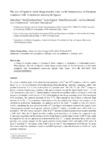Mostrar o rexistro simple do ítem
The role of ligand to metal charge-transfer states on the luminescence of Europium complexes with 18-membered macrocyclic ligands
| dc.contributor.author | Nonat, Aline | |
| dc.contributor.author | Esteban-Gómez, David | |
| dc.contributor.author | Valencia, Laura | |
| dc.contributor.author | Pérez-Lourido, Paulo | |
| dc.contributor.author | Barriada, José Luis | |
| dc.contributor.author | Charbonnière, Loïc J. | |
| dc.contributor.author | Platas-Iglesias, Carlos | |
| dc.date.accessioned | 2021-12-03T10:13:34Z | |
| dc.date.available | 2021-12-03T10:13:34Z | |
| dc.date.issued | 2019-02-27 | |
| dc.identifier.citation | A. Nonat, D. Esteban-Gómez, L. Valencia, P. Pérez-Lourido, J. L. Barriada, L. J. Charbonnière and C. Platas-Iglesias, The role of ligand to metal charge-transfer states on the luminescence of Europium complexes with 18-membered macrocyclic ligands, Dalt. Trans., 2019, 48, 4035–4045. DOI: 10.1039/C8DT05005H. | es_ES |
| dc.identifier.issn | 1477-9234 | |
| dc.identifier.uri | http://hdl.handle.net/2183/29067 | |
| dc.description.abstract | [Abstract] We report a detailed study of the photophysical properties of EuIII and TbIII complexes with two ligands based on a 3,6,10,13-tetraaza-1,8(2,6)-dipyridinacyclotetradecaphane platform containing either four pyridine-2yl-methyl (L1) or four hydroxyethyl (L2) pendant arms. The [TbL1]3+ and [TbL2]3+ complexes present moderate luminescence quantum yields upon excitation through the ligand bands (ϕH2O = 7.4 and 21%, respectively). The [EuL2]3+ complex displays a relatively low quantum yield in H2O (ϕH2O = 1.6%) that increases considerably in D2O (ϕD2O = 5.3%), which highlights the strong quenching effect of the four ligand O–H oscillators. The emission spectrum of [EuL1]3+ is rather unusual in that it shows a relatively high intensity of the 5D0 → 7F5,6 transitions, which appears to be also related to the distorted D4d symmetry of the coordination polyhedron. Surprisingly, the quantum yield of the [EuL1]3+ complex is very low (ϕH2O = 0.10%), considering the good protection of the EuIII coordination environment offered by the ligand. Cyclic voltammograms recorded from aqueous solutions of [EuL1]3+ display a reversible curve with a half-wave potential of −620 mV (versus Ag/AgCl), while [EuL2]3+ presents a reduction peak at more negative potential (−1040 mV). Thus, the L1 ligand provides a rather good stabilisation of divalent Eu compared to the L2 analogue, suggesting that the presence of a low-lying ligand-to-metal charge-transfer (LMCT) state might be responsible for the low quantum yield determined for [EuL1]3+. A density functional theory (DFT) study provides very similar energies for the ligand-centered excited singlet (1ππ*) and triplet (3ππ*) states of [EuL1]3+ and [EuL2]3+. The energy of the 9LMCT state of [EuL1]3+ was estimated to be 20 760 cm−1 by using all-electron relativistic calculations based on the DKH2 approach, a value that decreases to 15 940 cm−1 upon geometry relaxation. | es_ES |
| dc.description.sponsorship | Ministerio de Economía y Competitividad; CTQ2016-76756-P | es_ES |
| dc.description.sponsorship | Xunta de Galicia; ED431B 2017/59 | es_ES |
| dc.description.sponsorship | Xunta de Galicia; ED431D 2017/01 | es_ES |
| dc.language.iso | eng | es_ES |
| dc.publisher | Royal Society of Chemistry | es_ES |
| dc.relation.uri | https://doi.org/10.1039/C8DT05005H | es_ES |
| dc.title | The role of ligand to metal charge-transfer states on the luminescence of Europium complexes with 18-membered macrocyclic ligands | es_ES |
| dc.type | info:eu-repo/semantics/article | es_ES |
| dc.rights.access | info:eu-repo/semantics/openAccess | es_ES |
| UDC.journalTitle | Dalton Transactions | es_ES |
| UDC.volume | 48 | es_ES |
| UDC.issue | 12 | es_ES |
| UDC.startPage | 4035 | es_ES |
| UDC.endPage | 4045 | es_ES |
Ficheiros no ítem
Este ítem aparece na(s) seguinte(s) colección(s)
-
GI-REACT! - Artigos [103]






